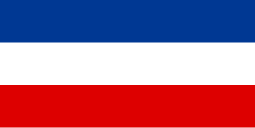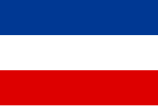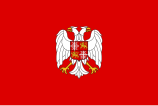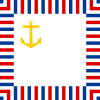Flag of Serbia and Montenegro
 | |
| Name | National flag of Serbia and Montenegro (2003–2006) |
|---|---|
| Use | National flag |
| Proportion | 1:2 |
| Adopted | 27 April 1992[1] |
| Design | Three equal horizontal bands, blue (top), white, and red |
 Variant flag of Federal Republic of Yugoslavia State Union of Serbia and Montenegro | |
| Use | Civil flag and ensign |
| Proportion | 2:3 |
| Adopted | 27 April 1992[2] |
| Design | Three equal horizontal bands, blue (top), white and red |
 Variant flag of Federal Republic of Yugoslavia State Union of Serbia and Montenegro | |
| Use | Naval ensign |
| Proportion | 2:3 |
| Adopted | 31 May 1993[3] |
 Variant flag of Federal Republic of Yugoslavia State Union of Serbia and Montenegro | |
| Use | Naval jack |
| Proportion | 2:3 |
| Adopted | 31 May 1993[4] |
The flag of Serbia and Montenegro was originally adopted on 27 April 1992 as the flag of the Federal Republic of Yugoslavia (FR Yugoslavia) and was used as such from 1992 to 2006. After the country was renamed to the State Union of Serbia and Montenegro in February 2003 it remained in use as the national flag until the country's dissolution in June 2006.[5]
Aside from a different aspect ratio, it is essentially the same flag that used by the Socialist Federal Republic of Yugoslavia (SFR Yugoslavia; 1943–1992) but without the red star in the centre, it was similar to an inverted Dutch flag.[6]
History[]
The flag of Serbia and Montenegro had its origins in the Flag of Yugoslavia used by the Kingdom of Yugoslavia which was later amended by the Socialist Federal Republic of Yugoslavia under Communist rule. Following the fall of communism and reconstitution of the country as the Federal Republic of Yugoslavia, the country initially retained the original SFR Yugoslavia flag.[7] However on 27 April 1992, the FR Yugoslavia adopted a new flag by removing the communist red star from the old one. This made Yugoslavia the last country in Europe to remove a red star from its flag.[7] However, due to United Nations Security Council Resolution 777, FR Yugoslavia was not permitted to inherit SFR Yugoslavia's United Nations membership. Between 1992 and 2000, the old SFR flag continued to fly outside the United Nations Headquarters as the new government refused to apply for membership as the Yugoslav government believed they were a direct continuation of the previous state. When FR Yugoslavia were allowed to join in 2000 following a successful application, the old flag was removed and replaced with the Federal Republic flag.[8]
The decision to change the flag was controversial with socialist parties in Yugoslavia. When it was unveiled, Socialist Party of Serbia councilors in Tutin, Serbia refused to work on the municipal council on the grounds that "the flag of another state is displayed in the offices of the Town Hall".[9] The International Olympic Committee also did not allow athletes from Yugoslavia to compete under the new flag at the 1992 Summer Olympics in Barcelona, Spain. Instead, they competed as Independent Olympic Participants at the 1992 Summer Olympics and marched under the neutral Olympic flag.[10]
In 2003, when Yugoslavia was renamed as Serbia and Montenegro, there was dispute over any new symbols to be used for the nation. It was alleged that the new Constitutional Charter of Serbia and Montenegro prohibited the use of the old Yugoslavian symbols until a law on them was brought before the Parliament of Serbia and Montenegro and one was required to be brought within sixty days of the new Parliament sitting.[11] However it was argued there was little point in changing the flag for the new state as the individual regional flags of Serbia and Montenegro only differed from the Yugoslav flag in the shade of blue used.[11] It was also argued that it was pointless trying to change the flag because the two sides would not be able to agree upon a logical new flag.[12] As predicted, the Serbian and Montenegrin delegations were unable to agree on a new flag so they continued to use the old Yugoslavian flag until the union's dissolution in 2006.[13] Some Serbians and Montenegrins started to reject the flag in favour of the old flag of SFR Yugoslavia due to a sense of nostalgia and due to a feeling of abandonment from the international community.[14] Montenegro did not support the flag continuing to be used to represent them and in 2004, the Parliament of Montenegro adopted a new flag to replace the flag of Serbia and Montenegro within their republic. However, this remained a regional flag within the union until Montenegrin independence in 2006.[15]
During the dispute following the change of name from Yugoslavia to Serbia and Montenegro, the flag was used to represent Serbia and Montenegro in football as UEFA allowed the Serbia and Montenegro national football team to continue to use the Yugoslavian flag and their Yugoslavian kits whilst the decision was made.[16][17] In 2006, shortly after the country's dissolution, the Serbia and Montenegro football team entered the 2006 FIFA World Cup using the flag they had qualified under.[18][19] Paradoxically the team was representing a country that no longer existed nor used the flag of Serbia and Montenegro as both countries upon independence adopted their own flags.[18][20]
Post-dissolution[]
Following Montenegro voting for independence and the union being dissolved by a unanimous vote of the Serbian deputies (as the Montenegrin deputies had boycotted it), the flag was lowered from the Parliament building in Belgrade on 5 June 2006.[21] At the Serbian military headquarters, the flag was ceremonially lowered to "Hey, Slavs", the Serbian and Montenegrin national anthem, overseen by the Minister of Defence Zoran Stanković.[20] Following the dissolution of Serbian and Montenegro, the two successor states adopted their own flags. Montenegro continued to use the regional flag they had adopted in 2004.[22] Serbia adopted a new flag using the same colours of the flag of Serbia and Montenegro (with the three coloured bars in a different order) but included the coat of arms of Serbia defaced on it.[20]
Other flags[]
| Flag | Date | Use | Description |
|---|---|---|---|
 |
2003[23] | Serbian tricolour | |
 |
2004–2006[24] | Serbian tricolour with small coat of arms on the left side | |
 |
1992–2004[25] | Serbian tricolour | |
 |
2004–2006[26] | Red field with golden border and Montenegrin coat of arms in the center | |
| 1993–2004[27] | Serbian tricolour with lighter shade of blue | ||
 |
1992–1993 | Serbian tricolour with Red Star in the center | |
 |
1993–2006[28] | 1:1 proportioned Yugoslav tricolour with the Serbian eagle (version used by Serbia and Montenegro) in the center and blue-red border fleury | |
 |
1995–2006[29] | 1:1 proportioned Yugoslav tricolour | |
 |
1995–2006[30] | 1:1 proportioned Yugoslav tricolour with Serbian eagle in the center (version used by Serbia and Montenegro) | |
 |
1995–2006[31] | 1:1 proportioned Yugoslav tricolour with small emblem of the Armed Forces in the center | |
 |
1995–2006[32] | 1:1 proportioned white field with Serbian eagle in the center (Serbo-Montenegrin version) plus blue and red stripes at the border |
Rank flags[]
| Flag | Date | Use | Description |
|---|---|---|---|
 |
1993–2006 | 1:1 Yugoslav tricolour with blue and red stripes at the border plus a golden anchor in the upper left corner | |
 |
1993–2006 | 1:1 proportioned white field with golden anchor in the upper left corner and blue and red stripes at the border | |
 |
1993–2006 | 1:1 proportioned red field with blue and red stripes at the border and a golden anchor in the upper left corner | |
 |
1993–2006 | 1:1 proportioned blue field with golden anchor in the upper left corner and blue and red stripes at the border |
See also[]
- Coat of arms of Serbia and Montenegro
- Coat of arms of Serbia
- Coat of arms of Montenegro
- Flag of Yugoslavia
- List of Yugoslav flags
- Flag of Serbia
- List of Serbian flags
- Flag of Montenegro
- List of flags of Montenegro
References[]
- ^ "National Flag". The Flags & Arms of the Modern Era. Archived from the original on 2018-06-21. Retrieved 2018-07-05.
- ^ "Civil Ensign". The Flags & Arms of the Modern Era. Archived from the original on 2018-06-21. Retrieved 2018-07-05.
- ^ "Naval Ensign". The Flags & Arms of the Modern Era. Archived from the original on 2018-06-21. Retrieved 2018-07-05.
- ^ "Jack". The Flags & Arms of the Modern Era. Archived from the original on 2018-06-21. Retrieved 2018-07-05.
- ^ "Serbia and Montenegro (2003–2006)". Flags of the World. Archived from the original on 21 November 2017. Retrieved 5 July 2018.
- ^ "Balkan fans cheer dead country". 12 February 2003. Archived from the original on 3 June 2019. Retrieved 23 January 2019 – via news.bbc.co.uk.
- ^ a b McAdams, Michael (1992). Croatia: Myth and Reality. CIS Publishing. p. 15. ISBN 9780963362513.
- ^ Steele, Johnathon (2000-11-02). "UN welcomes Yugoslavia and furls Tito's flag". The Guardian. Archived from the original on 2021-05-23. Retrieved 2021-05-23.
- ^ Spotlight on: Human Rights in FR Yugoslavia : 1998 Report. 28. Humanitarian Law Center. 1999. p. 38. Archived from the original on 2021-06-05. Retrieved 2021-06-05.
- ^ Scharf, Michael (2001). The Law of International Organizations: Problems and Materials. Carolina Academic Press. p. 109. ISBN 9780890899465.
- ^ a b "Serbia-Montenegro: Search For New Coat Of Arms, Flag Symbolic Of Past Conflict". Radio Free Europe/Radio Liberty. 2003-02-10. Archived from the original on 2021-05-17. Retrieved 2021-05-17.
- ^ Schuman, Michael (2014). Serbia and Montenegro. Infobase Publishing. p. 12. ISBN 978-1438122526.
- ^ Price, Matthew (2003-10-07). "Belgrade flag flap reveals identity crisis". BBC News. Archived from the original on 2009-01-12. Retrieved 2021-05-17.
- ^ Kampschror, Beth (2005-08-15). "In troubled Balkans, nostalgia rises for Yugoslavia". Christian Science Monitor. Archived from the original on 2021-05-24. Retrieved 2021-05-24.
- ^ "Montenegro picks national symbols". BBC News. 2004-07-13. Archived from the original on 2007-09-11. Retrieved 2021-05-27.
- ^ "Serbia and Montenegro debut". UEFA. 11 February 2003. Archived from the original on 2021-05-17. Retrieved 2021-05-17.
- ^ Price, Matthew (2003-02-12). "Balkan fans cheer dead country". BBC News. Archived from the original on 2017-09-09. Retrieved 2021-05-17.
- ^ a b "Flags". MacMillan. 2006. Archived from the original on 2021-05-17. Retrieved 2021-05-17. Cite journal requires
|journal=(help) - ^ "Germany in tough on Friday". The Province. 2006-06-29. Archived from the original on 2021-05-17. Retrieved 2021-05-17 – via Newspapers.com.
- ^ a b c "Serbia Flag". Associated Press. 2006-06-06. Archived from the original on 2021-05-17. Retrieved 2021-05-17.
- ^ "At a Glance". The Daily Reporter. 2006-06-05. Archived from the original on 2021-05-17. Retrieved 2021-05-17 – via Newspapers.com.
- ^ "Flag of Montenegro". Encyclopedia Britannica. Archived from the original on 2020-07-16. Retrieved 2021-05-17.
- ^ "Belgrade flag flap reveals identity crisis". BBC News. Archived from the original on 2009-01-12. Retrieved 2018-07-05.
- ^ "State Flag, 2004 – 2010". The Flags & Arms of the Modern Era. Archived from the original on 2018-07-05. Retrieved 2018-07-05.
- ^ "Republic of Serbia, 1992 – 2004". The Flags & Arms of the Modern Era. Archived from the original on 2018-07-05. Retrieved 2018-07-05.
- ^ "Republic of Montenegro". The Flags & Arms of the Modern Era. Archived from the original on 2017-09-27. Retrieved 2018-07-05.
- ^ "Republic of Montenegro, 1993 – 2004". The Flags & Arms of the Modern Era. Archived from the original on 2017-09-27. Retrieved 2018-07-05.
- ^ "President of the Republic". The Flags & Arms of the Modern Era. Archived from the original on 2018-06-21. Retrieved 2018-07-05.
- ^ "Prime Minister". The Flags & Arms of the Modern Era. Archived from the original on 2017-09-10. Retrieved 2018-07-05.
- ^ "High Defence Council Member". The Flags & Arms of the Modern Era. Archived from the original on 2017-09-10. Retrieved 2018-07-05.
- ^ "Minister of Defence". The Flags & Arms of the Modern Era. Archived from the original on 2017-09-10. Retrieved 2018-07-05.
- ^ "Chief of the General Staff". The Flags & Arms of the Modern Era. Archived from the original on 2017-09-10. Retrieved 2018-07-05.
External links[]
| Wikimedia Commons has media related to Flags of Serbia and Montenegro. |
- Serbia and Montenegro
- Flags of Yugoslavia
- Obsolete national flags
- 1992 establishments in Yugoslavia
- 2006 disestablishments in Serbia and Montenegro
- 2006 disestablishments in Serbia
- 2006 disestablishments in Montenegro